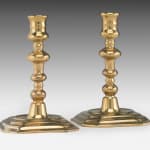Pair of William and Mary Brass Candlesticks
ENGLAND, CIRCA 1690
19.5 x 12.25 x 12.25 cm
7 ¾ x 4 ¾ x 4 ¾ in
7 ¾ x 4 ¾ x 4 ¾ in
7144
Each with a moulded socket topping a knopped stem, raised on a large moulded square base with cut corners and a central dish. The form, which is typical of the...
Each with a moulded socket topping a knopped stem, raised on a large moulded square base with cut corners and a central dish.
The form, which is typical of the period, is illustrated in John Caspall, Fire and Light in the Home pre-1820, (Antique Collectors' Club, 2000), p. 104 fig. 2.
See 'Country House Lighting', (Temple Newsam, Leeds City Art Galleries) p. 52 no. 17 for a pair of similar form engraved with the armorials of Charles, third Earl of Carlisle. They are described as 'in a simplified Continental Baroque style and in stark contrast to the columnar 'monument' sticks being produced by native-born craftsmen.' (ibid.). Pairs of candlesticks in silver and of comparable form were made by Pierre Harache, a silversmith who emigrated to London from France. See also Geoffrey Wills, Candlesticks (New York, 1974) fig. 35 p. 57.
The form, which is typical of the period, is illustrated in John Caspall, Fire and Light in the Home pre-1820, (Antique Collectors' Club, 2000), p. 104 fig. 2.
See 'Country House Lighting', (Temple Newsam, Leeds City Art Galleries) p. 52 no. 17 for a pair of similar form engraved with the armorials of Charles, third Earl of Carlisle. They are described as 'in a simplified Continental Baroque style and in stark contrast to the columnar 'monument' sticks being produced by native-born craftsmen.' (ibid.). Pairs of candlesticks in silver and of comparable form were made by Pierre Harache, a silversmith who emigrated to London from France. See also Geoffrey Wills, Candlesticks (New York, 1974) fig. 35 p. 57.




